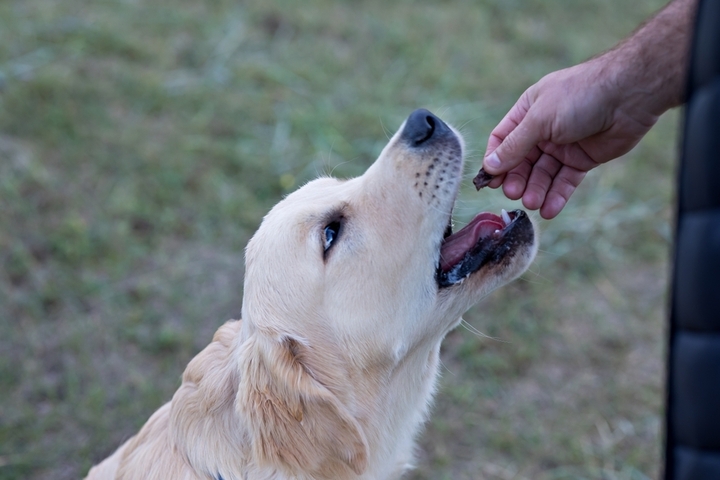
DogFoodAdvisor is reader supported See how
All reviews are 100% impartial but if you buy using links on this page, we may earn a referral fee.
Training treats are a wonderful way to reward good behavior and extremely helpful when it comes to training.
This is why we want to share The Dog Food Advisor’s favorite dog training treats.
Now, we don’t look at dog treats in the same way we look at dog food. There are several reasons why.
For one, dog treats aren’t regulated in the same way dog food is, so we can’t analyze them against official guidelines.
Also, treats are not dog food — they’re additional to and not part of a complete diet.
Small dog treats are key to keeping a training session moving along. Even for large dogs, a pea-sized treat is plenty. For small dogs, you can use even tinier pieces.
And finally, treats are treats! Sometimes you treat kids with carrots, sometimes with candy. It’s the same with dogs. Some treats can be a little naughty… in small doses.
That said, we’ve done our best to select treats that don’t include any nasties.
We sincerely hope your pooch will be rolling over (and sitting and begging and shaking hands) with joy when they taste them.
-
-
Redbarn Air Dried Beef Training Treats

These treats are natural, high-protein treats for dogs. Air-dried to help maintain the nutritional value of the fish or meat.
Redbarn Air Dried Beef Training Treats -
Orijen Original Freeze-Dried Dog Treats

Quality proteins freeze-dried to lock in nutrients and flavor.
Orijen Original Freeze-Dried Dog Treats -
The Honest Kitchen Surf & Turf Meaty Littles

Human-grade made with 80% chicken and no artificial ingredients.
The Honest Kitchen Surf & Turf Meaty Littles -
Stella & Chewy's Lamb Heart Treats

100% lamb, freeze-dried raw and grain and gluten free.
Stella & Chewy's Lamb Heart Treats -
Vital Essentials Freeze-Dried Raw Salmon Bites

Whole animal protein, freeze-dried raw and grain and gluten free.
Vital Essentials Freeze-Dried Raw Salmon Bites
-

The Best Training Treats for Dogs
Training a dog can be a complex and nuanced process. Here are some common questions we have had from our readers about how to train their dogs:
Frequently Asked Questions
How do I start training my dog from scratch?
Starting to train your dog from scratch can be a rewarding experience but it’s important to set realistic expectations.
Understand that training takes time and patience. Be prepared for gradual progress and occasional setbacks.
Decide on the training methods you want to use. Positive reinforcement, which involves rewarding good behavior, is generally recommended for beginners.
Get the supplies you’ll need, including treats, a leash, a collar or harness, and a quiet training space.
Begin with simple, essential commands like “sit,” “stay,” and “come.” These commands lay the foundation for more advanced training.
Teach your dog to recognize and respond to their name. Say their name in a cheerful tone and reward them when they look at you.
Choose a clear and consistent command word for each behavior. For example, use “sit” for sitting and “come” for coming to you.
When your dog performs the desired behavior, immediately reward them with a treat, praise, and affection. Make sure the reward is delivered within a second or two of the behavior.
Consistency is crucial in training. Always use the same command word and reward system so your dog can understand what you expect.
Dogs have short attention spans, so keep training sessions brief, around 10-15 minutes at a time. Frequent, short sessions are more effective than long, infrequent ones.
Be patient with your dog. If they don’t understand a command or make a mistake, avoid scolding. Instead, redirect them to the correct behavior and reward when they get it right.
Once your dog masters a command in a quiet environment, practice it with gradually increasing distractions to help them generalize the behavior.
Gradually reduce the frequency of treats as your dog becomes more proficient. Transition to rewarding with treats randomly to maintain the behavior.
Consistency is key, so practice commands and behaviors daily. This helps reinforce learning and keeps your dog sharp.
What is positive reinforcement, and why is it important in dog training?
Positive reinforcement is a widely used and effective training technique in which desirable behaviors are encouraged and strengthened by rewarding them with something the dog finds rewarding, typically treats, praise, or affection. The central idea behind positive reinforcement is to associate good behavior with pleasant consequences, making the dog more likely to repeat that behavior in the future.
Positive reinforcement training helps build a strong, trusting bond between you and your dog. Your dog learns that you are a source of good things, making them eager to please you.
Dogs respond better to positive, reward-based training because it makes the learning process enjoyable and less stressful. It fosters a positive attitude and willingness to engage in training sessions.
Punishment-based training methods can lead to fear, anxiety, and aggression in dogs. Positive reinforcement, on the other hand, creates a safe and non-threatening learning environment, reducing the risk of these negative emotional responses.
Positive reinforcement can be applied to dogs of all ages, breeds, and temperaments. It is versatile and adaptable to various training needs.
Dogs learn to associate specific cues or commands with actions and rewards, making communication between you and your dog clearer and more effective.
Dogs are motivated by rewards, and positive reinforcement taps into their natural desire for food, play, and affection. This motivation makes them more eager to participate in training.
Consistent use of positive reinforcement helps reinforce obedience and reinforces the importance of following commands.
By focusing on rewarding desired behaviors, positive reinforcement indirectly reduces undesirable behaviors because dogs learn what is expected of them.
Dogs engaged in positive reinforcement training often become better problem solvers as they learn to think about how to earn rewards.
Dogs that are trained using positive reinforcement tend to have higher self-esteem and confidence because they feel successful in their training efforts.
Positive reinforcement aligns with ethical principles of humane and responsible dog training. It avoids causing fear, pain, or harm to the dog.
In summary, positive reinforcement is a humane, effective, and ethical approach to dog training. It focuses on rewarding desired behaviors, creating a positive and enjoyable learning experience for both you and your dog while strengthening your bond and communication. This approach is widely recommended by professional dog trainers and behaviorists for its numerous benefits in promoting well-behaved, happy dogs.
What are the most essential commands to teach my dog?
Teaching your dog essential commands is important for their safety, obedience, and overall well-being. Here are some of the most essential commands to teach your dog:
Sit: Teaching your dog to sit is one of the most basic and fundamental commands. It’s useful in various situations, such as when you want your dog to be calm, wait for something, or greet people politely.
Stay: The “stay” command helps your dog remain in one place until you give them permission to move. It’s essential for safety and control, especially when crossing streets or in potentially dangerous situations.
Come (Recall):
A strong recall command is crucial for your dog’s safety. It ensures they come to you promptly when called, even when they’re distracted or off-leash.
Down (Lie Down): The “down” command instructs your dog to lie down on their stomach. It’s useful for controlling your dog, keeping them calm, or preventing jumping on people.
Leave It/Drop It: Teaching your dog to “leave it” or “drop it” is vital for their safety. It can prevent them from picking up harmful items, such as food or objects that could be dangerous if ingested.
Heel (Walking on a Loose Leash): “Heel” teaches your dog to walk calmly and closely by your side without pulling on the leash. It makes walks more enjoyable and safer.
Off (No Jumping): Teaching your dog to get “off” means they should stop jumping on people or furniture. This is especially important when guests are present.
Wait (Impulse Control): The “wait” command instructs your dog to pause and wait for further instructions. It’s handy for controlling their movements and preventing impulsive behavior.
Bed: The “bed” command designates a specific spot where your dog should go and stay. It’s useful for controlling their location when you need them out of the way.
Quiet (No Barking): Teaching your dog to be “quiet” can help manage excessive barking, ensuring peace and quiet in your home.
Stand (Useful for Grooming and Vet Visits): Teaching your dog to “stand” can be helpful during grooming sessions or veterinary examinations.
Back/Move Back: “Back” or “move back” commands are useful for getting your dog to step backward. This can be handy for managing space or situations where your dog needs to back away.
Release/Okay (End of Command): Use a release command like “release” or “okay” to signal to your dog that they are free to move or stop performing a previously given command.
How do I maintain consistency in training across family members or caregivers?
In order for your dog to understand what is expected in his daily family interactions, each person he lives with or cares for him must be on the same page. Everyone should use the same cues and techniques for training.
Dogs are not born understanding English, they learn words quickly, but need to be taught word meanings clearly and concisely. They do not know that “sit” and “sit down” mean the same thing, no one in the family has to be a professional, just ensure consistency. Training will then be quicker, easier and more fun for all, especially your dog.
What should I do if my dog doesn't respond to training or has behavior problems?
It takes time and patience to train your dog or stamp out unwanted behavior, if your consistency and positive reinforcement has not paid off then it may be time to enlist the help of a professional. Professional dog training and socialization classes are great for all dogs as a supervised, safe way to explore new behavioral skills.
Is it ever too late to train an older dog?
Regardless of the reason why your dog has not been trained at a younger age or that they have developed unwanted behaviors, it’s never too late to ‘teach an old dog new tricks’ Training a dog as an adult can be beneficial in some ways — they may be less distractible and energetic than they were as a puppy.
Consistency and patience is key.
Final word
The Dog Food Advisor does not accept money, gifts, samples or other incentives in exchange for special consideration in preparing our reviews.
However, we do receive a referral fee from online retailers (like Chewy or Amazon) and from sellers of perishable pet food when readers click over to their websites from ours. This helps cover the cost of operation of our free blog. Thanks for your support.
For more information, please visit our Disclaimer and Disclosure page.




